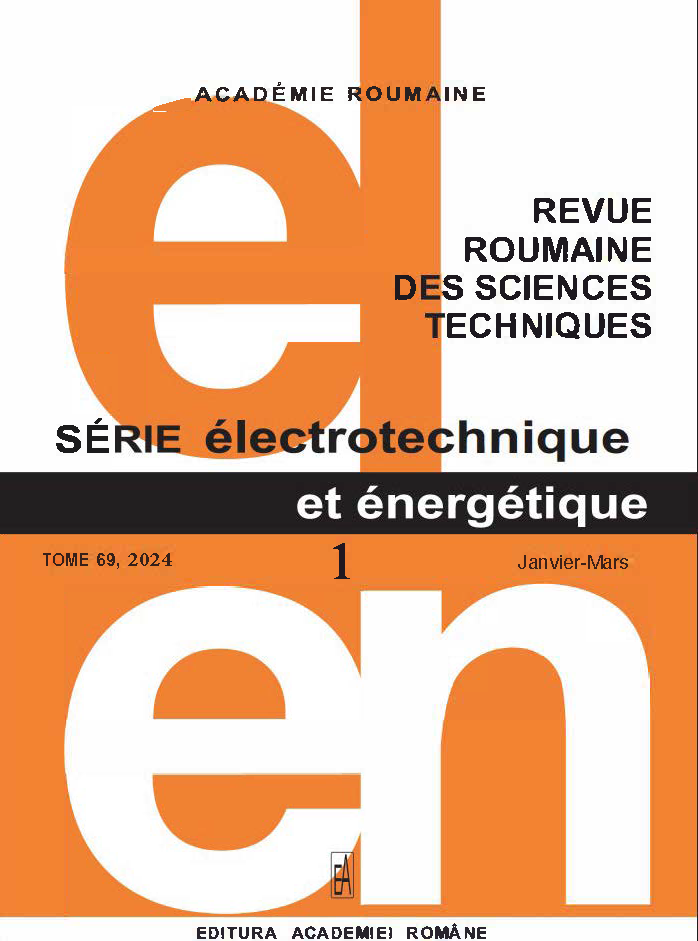AFRICAN VULTURE OPTIMIZED INTEGRATED CONTROL TECHNIQUE FOR PV-FED OPEN-END WINDING INDUCTION MOTOR PUMP APPLICATION
DOI:
https://doi.org/10.59277/RRST-EE.2024.1.5Keywords:
Open-end winding induction motors, Photovoltaic, Scalar coupled pulse with modulation (PWM), African vulture optimization, Dual inverter, Maximum power point tracking (MPPT), Total harmonic distortion (THD)Abstract
Open-end winding induction motors (OEWIM) have gained much attention, and they are used for solar photovoltaic (PV) fed pumping applications as a compromise alternative to multi-level inverters. Solar irradiance conditions further exacerbate the nonlinear control problem, resulting in significant loss of power and low reliability, which affects motor operation. To overcome these issues, this paper presents an optimized integrated control technique-based PV integrated three-level dual inverter fed Open-end winding induction motors for pumping application. An integrated African vulture optimization algorithm and scalar coupled pulse width modulation (AVO-SCPWM) based control techniques are proposed to extract the maximum power from the solar PV source and control the induction motor pump. Here, the AVO-based maximum power point tracking (MPPT) technique adjusts the modulation index (ma) by insolation and temperature. The proposed technique balances the zero-sequence current, reduces THD, and reduces the switching losses over the inverter. The proposed work is evaluated in MATLAB/Simulink software and compared with the existing conventional induction motor (IM), Conventional OEWIM Drive, and scalar decoupled PWM-based IM techniques under two climatic conditions. Thus, the simulation results demonstrate that the proposed technique accomplishes better than the existing techniques.
References
(1) B. Mountain, P. Szuster, Solar, solar everywhere: opportunities and challenges for Australia’s rooftop PV systems, IEEE Power Energy Mag., 13, 4, pp. 53–60 (2015).
(2) A.A.A. Radwan, Y.A.R.I. Mohamed, Power synchronization control for grid-connected current-source inverter-based photovoltaic systems, IEEE Trans. Energy Conv., 31, 3, pp. 1023–1036 (2016).
(3) M.A. Elgendy, B. Zahawi, D.J. Atkinson, Operating characteristics of the P&O algorithm at high perturbation frequencies for standalone PV systems, IEEE Trans. Energy Conv., 30, 1, pp. 189–198 (2015).
(4) A. Costabeber, M. Carraro, M. Zigliotto, Convergence analysis and tuning of a sliding-mode ripple-correlation MPPT, IEEE Trans. Energy Conv., 30, 2, pp. 696–706 (2015).
(5) U.K. Kalla, N. Bhati, K. Chariya, I. Qureshi, I Design and analysis of solar PV fed IMD water-pumping system, In 2021 International Conference on Sustainable Energy and Future Electric Transportation (SEFET), IEEE, pp. 1–6 (2021).
(6) Y. Jiang, J.A.A. Qahouq, M. Orabi, Ac PV solar system distributed architecture with maximum power point tracking, Proc. IEEE International Telecommunications Energy Conference, IEEE-INTLEC'12, Scottsdale (AZ), USA (2012).
(7) S. Jain, A.K. Thopukara, R. Karampuri, V.T. Somasekhar, A single-stage photovoltaic system for a dual inverter-fed open-end winding induction motor drive for pumping applications, IEEE Trans. Power Electron., 30, 9, pp. 4809–4818 (2015).
(8) M.W. Shah, R.L. Biate, Design and simulation of Solar PV model using MATLAB/Simulink, International Journal of Scientific & Engineering Research, 7, 3, pp. 551–554 (2021).
(9) T. Ma, H. Yang, L. Lu, Solar photovoltaic system modeling and performance prediction, Renewable and Sustainable Energy Reviews, 36, pp. 304–315 (2014).
(10) S. Jain, A.K. Thopukara, R. Karampuri, V.T. Somasekhar, A single-stage photovoltaic system for a dual-inverter-fed open-end winding induction motor drive for pumping applications, IEEE Trans. on power Electronics, 30, 9, pp. 4809–4818 (2014).
(11) J. Korhonen, J. Honkanen, T.J. Kärkkäinen, J. Nerg, P. Silventoinen, Modulation and control methods to reduce zero sequence current in open-end winding motors, in 2017 IEEE International Electric Machines and Drives Conference (IEMDC), IEEE, pp. 1–6 (2017).
(12) G.A. Ghazi, H.M. Hasanien, E.A. Al-Ammar, R.A. Turky, W. Ko, S. Park, H.J. Choi, African vulture optimization algorithm-based pi controllers for performance enhancement of hybrid renewable-energy systems, Sustainability, 14,13, pp. 8172 (2022).
(13) A. Hossam-Eldin, H. Mostafa, H. Kotb, K.M. AboRas, A. Selim, S. Kamel, Improving the frequency response of hybrid microgrid under renewable sources’ uncertainties using a robust lfc-based African vulture optimization algorithm, Processes, 10, 11, pp. 2320 (2022).
(14) D. Benoudjit, S. Rid, N. Nait-Said, M. Saidnait-Said, L. Chrifi-Alaoui, Electric vehicle propelled by dual-induction motors structure: experimental results, Rev. Roum. Sci. Techn. – Électrotechn. Et Énerg., 68, 2, pp. 170–175 (2023).
(15) R. Sheeja, R. Nishant, Reduction in greenhouse gas emission by using sustainable transportation systems to increase the environmental and economic benefits, International Journal of System Design and Computing, vol. 01, 01, pp. 18–25 (2023).
(16) B. Sivasankari, M. Shunmugathammal, A. Appathurai, and M. Kavitha, High-throughput and power-efficient convolutional neural network using one-pass processing elements, Journal of Circuits, Systems and Computers, 31, 13, pp. 225–226 (2022).
(17) E.G. Boudissa, F. Habbi, M. Bounekhla, N. Dif, A memetic algorithm applied to induction machine parameters identification based on an output error: memetic algorithm for induction machine identification, Rev. Roum. Sci. Techn. – Électrotechn. Et Énerg.,68, 3, pp. 266–270 (2023).
(18) K.K. Kumar, M.W. Iruthayarajan, A.S. Kamaraja, Investigation of a solar incorporated improved quasi-Y-source dc–dc step-up converter connected with phase-shifted converter in electric vehicle battery charging, Electr. Eng., 105, pp. 3647–3667 (2023).
(19) P. Deepa, S. Rajakumar, P.J. Shermila, E.A. Devi, M.E. Prince, A.J.G. Malar, New hybrid Cuk-Landsman high gain dc-dc converter modelling and analysis, Power, 9, 8, pp. 8-16 (2022).
(20) A. Agasthian, R. Pamula, L.A. Kumaraswamidhas, Integration of monitoring and security based deep learning network for wind turbine system, International Journal of System Design and Computing, 01, 01, pp. 11-17 (2023).
(21) S.V. Lakshmi, M.A. Rejula, K. Sujatha, A. Ahilan, Recognition of brain stroke shape using multiscale morphological image processing, The Imaging Science Journal, 69, (1-4), pp. 28-37 (2021).
Downloads
Published
Issue
Section
License
Copyright (c) 2024 REVUE ROUMAINE DES SCIENCES TECHNIQUES — SÉRIE ÉLECTROTECHNIQUE ET ÉNERGÉTIQUE

This work is licensed under a Creative Commons Attribution-NonCommercial-NoDerivatives 4.0 International License.


